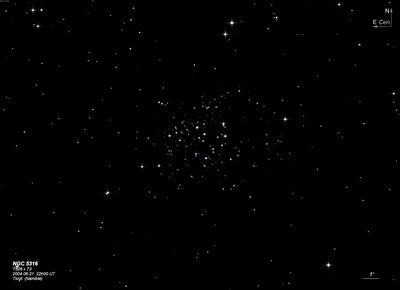
10x30mm Canon IS (3/27/19 - Tasmania): fairly faint, moderately large cluster in binoculars, irregular shape, no obvious resolution.
James Dunlop discovered NGC 5316 = D 282 = h3542 on 25 May 1826 and described "A group of ten or twelve stars about the 10th mag, with a multitude of very small stars, forming an irregular branched figure, 8' or 10' long and 6' broad." His position is only off by 3'. JH observed the cluster on 24 Apr 1835 and noted it as a "cluster of stars, class VII; 14 stars 11th mag, and 30 or 40 smaller in a round space 8' diameter." He credited Dunlop, due to his relatively accurate position.
300/350mm - 13.1" (2/19/04 - Costa Rica): this fairly bright open cluster consists of 35-40 stars in a 10' triangular group. Includes a number of brighter mag 9.5-12 stars. Off the NE side is a neat string of stars oriented WNW-ESE.
400/500mm - 18" (7/5/05 - Magellan Observatory, Australia): at 171x (12mm Nagler), over three dozen stars are visible in a 10'x6' bright triangular group. A number of mag 10 and 11 stars define the periphery and make the cluster appear well-detached although a number of additional mag 9 and 10 adorn a glittering field. Extending off the north side and heading NW is a 6' string of 11th-12th magnitude stars ending at a mag 10.8 star 7' NW of the center of the cluster. The chain then abruptly changes direction and continues SW, terminating at mag 8.5 HD 120631 located 10' W of the center of the cluster. The two intersecting strings are distinctive but appear to be random asterisms.
Notes by Steve Gottlieb